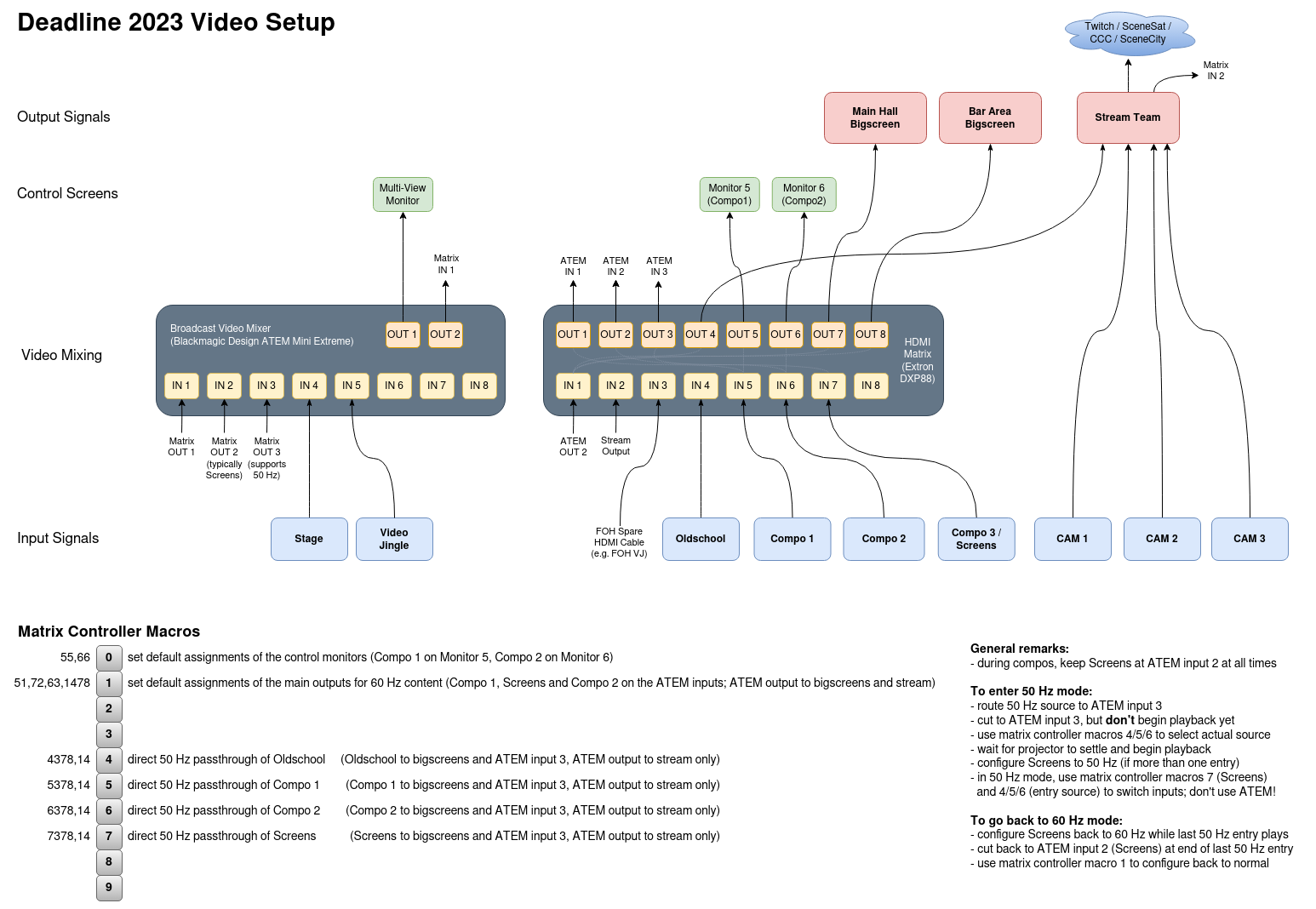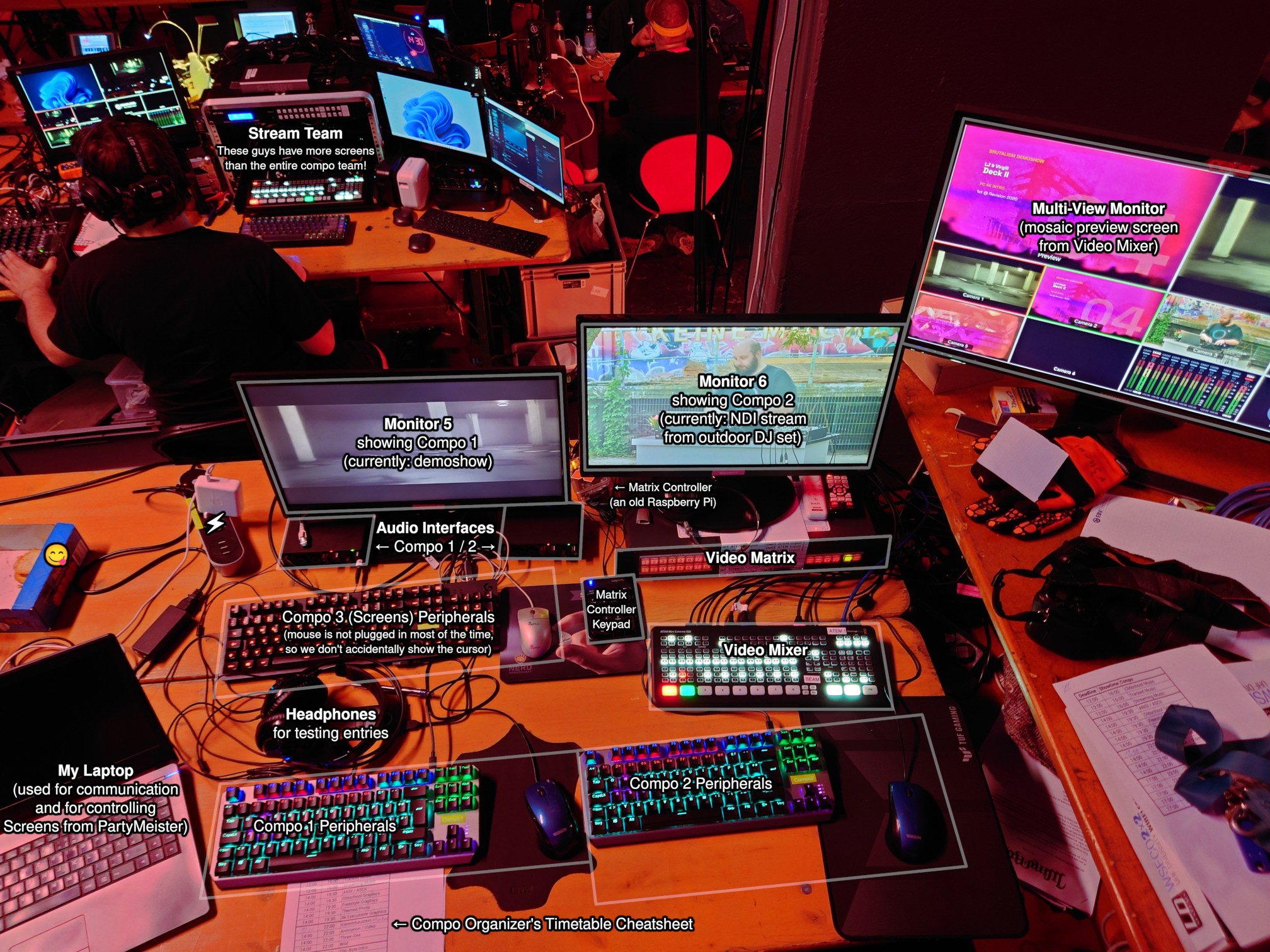Info on AV / stream management on a demoparty
category: general [glöplog]
i think the plan does not include the 2 small hdmi splitters after the compo machines, for the edid reasons kb stated above. i also started to compile a somewhat useful list of tried and good stuff used at amazon. sorry for evil amazon: https://www.amazon.de/hz/wishlist/ls/1S1RC67TYCNYX
kbの投稿の内容(今年のRevisionの配線について)を日本語に翻訳しました!:
https://scrapbox.io/0b5vr/Revision_2023%E3%81%AE%E9%85%8D%E7%B7%9A%E5%9B%B3
(I've translated the kb's post to ja. Thank you for the resource!)
https://scrapbox.io/0b5vr/Revision_2023%E3%81%AE%E9%85%8D%E7%B7%9A%E5%9B%B3
(I've translated the kb's post to ja. Thank you for the resource!)
Now that Evoke is over, here is the A/V plan.
It's pretty similar to the Revision one, with a bunch of peculiarities and/or enhancements tho:
- As Evoke has got way too many screens scattered throughout the location, and those screens might need to be switched independently, we need a lot of outputs. The solution: Just rent a bigger HDMI matrix. 16x16 is totally exaggerated on the input side but we did end up needing 14 of the 16 outputs, as we also connected all of the monitors on the bridge directly to the matrix, with no splitters in between. Less hardware, less cabling, yay. :)
- the Slides PC had two outputs; the second one was responsible to display the "social wall" on the 2nd screen next to the bigscreen while no compo was running
- No need for two redundant compo PCs plus a stuff one, we can do that with one less. :)
- We added a "Control" PC in the middle whose only responsibility was to... control. Or to be precise, control Partymeister, the ATEM and the Matrix, without being connected to the A/V setup at all, so no fear of accidentally putting anything on screen that didn't belong.
- To avoid a repeat of the 2022 Bass Incident, the audio was done with "CoDI"s which is a fancy name for a 2ch USB audio interface with balanced outs (class compliant, no drivers needed, and apart from making one certain Linux 4K intro crash they worked perfectly :))
Anyway, here's a diagram again:

It's pretty similar to the Revision one, with a bunch of peculiarities and/or enhancements tho:
- As Evoke has got way too many screens scattered throughout the location, and those screens might need to be switched independently, we need a lot of outputs. The solution: Just rent a bigger HDMI matrix. 16x16 is totally exaggerated on the input side but we did end up needing 14 of the 16 outputs, as we also connected all of the monitors on the bridge directly to the matrix, with no splitters in between. Less hardware, less cabling, yay. :)
- the Slides PC had two outputs; the second one was responsible to display the "social wall" on the 2nd screen next to the bigscreen while no compo was running
- No need for two redundant compo PCs plus a stuff one, we can do that with one less. :)
- We added a "Control" PC in the middle whose only responsibility was to... control. Or to be precise, control Partymeister, the ATEM and the Matrix, without being connected to the A/V setup at all, so no fear of accidentally putting anything on screen that didn't belong.
- To avoid a repeat of the 2022 Bass Incident, the audio was done with "CoDI"s which is a fancy name for a 2ch USB audio interface with balanced outs (class compliant, no drivers needed, and apart from making one certain Linux 4K intro crash they worked perfectly :))
Anyway, here's a diagram again:

This is what the setup looked like at this year's Deadline. There are very little changes compared to last year, because there's no need to fix what ain't broken:

That "matrix controller" thingie mentioned in the bottom part of the chart is essentially a numerical keypad with which the HDMI matrix can be controlled a little more conveniently. In particular, it supports macros, which comes in very handy for the complex switching processes that need to be done when going from 60 Hz to 50 Hz and vice-versa. (This extra effort is required because we absolutely want to show 50 Hz content as such on the bigscreen, but at the same time, we still need a 60 Hz conversion for the stream.)
For more details about the setup, read my Compo organizing manual.
One interesting thing we noticed is that on our ATEM Mini Extreme ISO, not all inputs are equal when it comes to 50 Hz tolerance: Inputs 1 and 2 show a broken image after switching to a 50 Hz source; the source needs to be unplugged and re-plugged (or temporarily assigned an empty input from the matrix) to resynchronize. However, we found out (by accident) that input 3 doesn't have any issues when switching the framerate. That was quite the pleasant surprise, because last year, when we used input 2 for 50 Hz content, we had to do the empty-input-and-back dance every so often.
We don't know whether this is an issue with the specific device we've been using or whether it's a general issue with all ATEM Minis, but it may be an interesting thing to know for other ATEM users.
Finally, if you're wondering what this looks like from the compo organizer's point of view:

(original image here)

That "matrix controller" thingie mentioned in the bottom part of the chart is essentially a numerical keypad with which the HDMI matrix can be controlled a little more conveniently. In particular, it supports macros, which comes in very handy for the complex switching processes that need to be done when going from 60 Hz to 50 Hz and vice-versa. (This extra effort is required because we absolutely want to show 50 Hz content as such on the bigscreen, but at the same time, we still need a 60 Hz conversion for the stream.)
For more details about the setup, read my Compo organizing manual.
One interesting thing we noticed is that on our ATEM Mini Extreme ISO, not all inputs are equal when it comes to 50 Hz tolerance: Inputs 1 and 2 show a broken image after switching to a 50 Hz source; the source needs to be unplugged and re-plugged (or temporarily assigned an empty input from the matrix) to resynchronize. However, we found out (by accident) that input 3 doesn't have any issues when switching the framerate. That was quite the pleasant surprise, because last year, when we used input 2 for 50 Hz content, we had to do the empty-input-and-back dance every so often.
We don't know whether this is an issue with the specific device we've been using or whether it's a general issue with all ATEM Minis, but it may be an interesting thing to know for other ATEM users.
Finally, if you're wondering what this looks like from the compo organizer's point of view:

(original image here)
thanks for sharing your experience!
keyj: Which reminds me that one day we should see if it's possible to manage having the stream switch between 50Hz and 60Hz without reconnecting it, too. All hope is lost with RTMP on that, but with SRT, it might be possible...
SRT typically carries MPEG-TS, which supports VFR (including mixed 50/60) just fine without a restart. The Solskogen stream had full VFR in 2016 (though directly to MP4 output, without going through MPEG-TS); we set the projector input as master clock for the stream, and switched that as needed.
YouTube's VOD doesn't deal too well with it, though.
YouTube's VOD doesn't deal too well with it, though.
(Well, 2016–2019; it wasn't a one-off)
